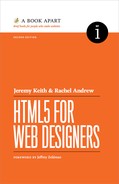INTRODUCTION
THE INITIAL VERSION of this book was published in 2010 when HTML5 was something developers were tentatively starting to use, despite concerns about problems with old browsers and new semantic elements. Today, it is rare to see someone starting a new site with anything other than an HTML5 doctype; the use of new HTML5 elements is commonplace. A whole generation of web designers is emerging that has only ever used HTML5.
When I was asked to work on an update of the book, I was somewhat nervous about the mixing of two voices and two perspectives. This is an opinionated book, and I wanted to approach this rewrite with a light touch—updating things that have changed, but maintaining the overall point of view. Thankfully, in most places, Jeremy’s thoughts and mine converge, so I’ve managed to avoid any arguments between two authors separated by five years!
In fact, I’ve been struck by how much has remained unchanged in that time. One of the arguments against HTML5 as a living standard is that this could make the language too fluid, ever-changing, something that we are constantly battling to keep up with. There have been tweaks to how we should use certain elements, and new features have been added, but, as it turns out, the advice in the first edition still mostly holds true today.
My update brings to the book some of the new features of HTML5, as well as those which had little support at the time of the first edition. We now have important elements such as picture, and accessibility issues caused by features like canvas have been addressed. I hope that my work has enhanced this short book, and will give it another few years of helping web designers better use HTML5.
—Rachel Andrew
